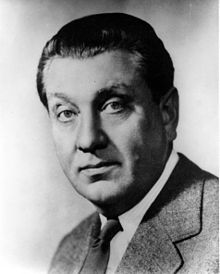William Walton Butterworth
William Walton Butterworth (born March 7, 1903 in New Orleans , Louisiana , † March 31, 1975 in Princeton , New Jersey ) was an American diplomat who served as Assistant Secretary of State for Far Eastern Affairs between 1949 and 1950 , from 1950 until 1953 ambassador to Sweden and later from 1959 to 1962 first US ambassador to the European Communities . Most recently he served as ambassador to Canada between 1962 and 1968 .
Life
Studies and beginning of the diplomatic career
After attending school, Butterworth first completed an undergraduate degree at Princeton University , from which he graduated in 1925 with a Bachelor of Arts (BA). After a summer semester in 1925 at the University of Dijon, he studied at Worcester College at the University of Oxford between 1925 and 1927 with the support of a Rhodes scholarship . After his return to the USA, he entered the foreign service and was initially Vice Consul in Singapore between 1929 and 1932 and then Third Secretary at the Embassy in Canada. He then moved to the embassy in the United Kingdom in 1933 , where he was only third secretary and from 1936 to 1941 second secretary. In addition, between 1935 and 1941 he was a representative of the Exchange Stabilization Fund (ESF), the stock exchange stabilization fund of the US Treasury.
After Butterworth served briefly as an exchange officer in the US Department of Commerce in 1941 , he was First Secretary at the Embassy in Portugal and Spain from 1942 to 1944, and between 1942 and 1944 he was also Director General for the operational business of the US trading company in Spain and Portugal active. At the same time he was from 1943 to 1944 representative of the Foreign Ministry at the North African Economic Committee in Algiers and then from 1944 to 1946 Counselor at the Embassy in Spain. In January 1946 he moved to China , where he was initially counselor in Chongqing and then from April 1946 to August 1947 counselor in Nanjing .
Assistant Secretary of State for Far Eastern Affairs and Ambassador
On his return to the United States, Butterworth was appointed head of the Far East Affairs Office in 1947 and as such was appointed Assistant Secretary of State for Far Eastern Affairs on September 29, 1949 . He was thus head of the Department for the Far East in the US State Department, but held the title of Assistant Secretary of State for Japanese Affairs from March 20, 1950 . On March 28, 1950, Dean Rusk was appointed another Assistant Secretary of State for Far Eastern Affairs , so Butterworth's term ended on July 4, 1950. On September 28, 1950 he succeeded H. Freeman Matthews as ambassador to Sweden and remained in this post until December 9, 1953.
After he was permanent representative of the ambassador to the United Kingdom between 1953 and 1956, he became ambassador to the European Coal and Steel Community (ECSC) in 1956 and held this office until 1959. At the same time he acted as ambassador to the European Atomic Energy Community (EURATOM) between 1958 and 1959 . From these functions, he became ambassador to the European Economic Community (EEC) on September 20, 1959, and finally, on August 10, 1961, ambassador to the European Communities (EC). He held this post until October 23, 1962 and was then replaced by John W. Tuthill .
Most recently Butterworth was ambassador to Canada on December 11, 1962, replacing Livingston T. Merchant there. He stayed in this office for almost six years until September 10, 1968, when Harold Francis Linder succeeded him . He then retired.
Butterworth, who was married, died of cirrhosis of the liver .
Web links
- Entry on the page of the Office of the Historian of the US State Department
- William Walton Butterworth in nndb (English)
Individual evidence
- ↑ He was succeeded as ambassador to Sweden on May 6, 1954 by the previous US ambassador to Pakistan , John Moors Cabot .
| personal data | |
|---|---|
| SURNAME | Butterworth, William Walton |
| BRIEF DESCRIPTION | American diplomat |
| DATE OF BIRTH | March 7, 1903 |
| PLACE OF BIRTH | New Orleans , Louisiana |
| DATE OF DEATH | March 31, 1975 |
| Place of death | Princeton , New Jersey |
